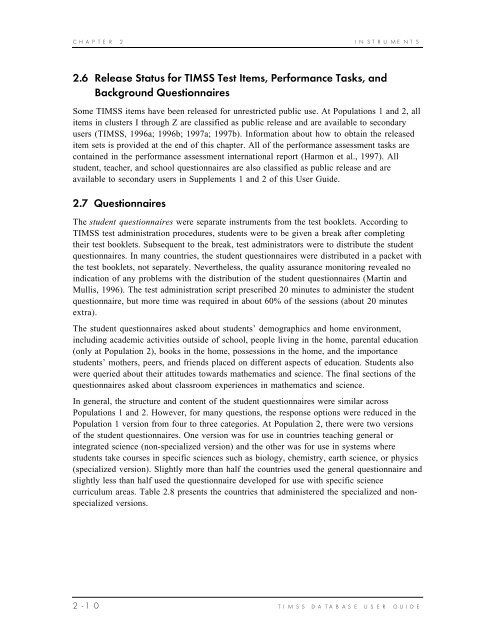User Guide for the TIMSS International Database.pdf - TIMSS and ...
User Guide for the TIMSS International Database.pdf - TIMSS and ...
User Guide for the TIMSS International Database.pdf - TIMSS and ...
You also want an ePaper? Increase the reach of your titles
YUMPU automatically turns print PDFs into web optimized ePapers that Google loves.
C H A P T E R 2 I N S T R U M E N T S<br />
2.6 Release Status <strong>for</strong> <strong>TIMSS</strong> Test Items, Per<strong>for</strong>mance Tasks, <strong>and</strong><br />
Background Questionnaires<br />
Some <strong>TIMSS</strong> items have been released <strong>for</strong> unrestricted public use. At Populations 1 <strong>and</strong> 2, all<br />
items in clusters I through Z are classified as public release <strong>and</strong> are available to secondary<br />
users (<strong>TIMSS</strong>, 1996a; 1996b; 1997a; 1997b). In<strong>for</strong>mation about how to obtain <strong>the</strong> released<br />
item sets is provided at <strong>the</strong> end of this chapter. All of <strong>the</strong> per<strong>for</strong>mance assessment tasks are<br />
contained in <strong>the</strong> per<strong>for</strong>mance assessment international report (Harmon et al., 1997). All<br />
student, teacher, <strong>and</strong> school questionnaires are also classified as public release <strong>and</strong> are<br />
available to secondary users in Supplements 1 <strong>and</strong> 2 of this <strong>User</strong> <strong>Guide</strong>.<br />
2.7 Questionnaires<br />
The student questionnaires were separate instruments from <strong>the</strong> test booklets. According to<br />
<strong>TIMSS</strong> test administration procedures, students were to be given a break after completing<br />
<strong>the</strong>ir test booklets. Subsequent to <strong>the</strong> break, test administrators were to distribute <strong>the</strong> student<br />
questionnaires. In many countries, <strong>the</strong> student questionnaires were distributed in a packet with<br />
<strong>the</strong> test booklets, not separately. Never<strong>the</strong>less, <strong>the</strong> quality assurance monitoring revealed no<br />
indication of any problems with <strong>the</strong> distribution of <strong>the</strong> student questionnaires (Martin <strong>and</strong><br />
Mullis, 1996). The test administration script prescribed 20 minutes to administer <strong>the</strong> student<br />
questionnaire, but more time was required in about 60% of <strong>the</strong> sessions (about 20 minutes<br />
extra).<br />
The student questionnaires asked about students’ demographics <strong>and</strong> home environment,<br />
including academic activities outside of school, people living in <strong>the</strong> home, parental education<br />
(only at Population 2), books in <strong>the</strong> home, possessions in <strong>the</strong> home, <strong>and</strong> <strong>the</strong> importance<br />
students’ mo<strong>the</strong>rs, peers, <strong>and</strong> friends placed on different aspects of education. Students also<br />
were queried about <strong>the</strong>ir attitudes towards ma<strong>the</strong>matics <strong>and</strong> science. The final sections of <strong>the</strong><br />
questionnaires asked about classroom experiences in ma<strong>the</strong>matics <strong>and</strong> science.<br />
In general, <strong>the</strong> structure <strong>and</strong> content of <strong>the</strong> student questionnaires were similar across<br />
Populations 1 <strong>and</strong> 2. However, <strong>for</strong> many questions, <strong>the</strong> response options were reduced in <strong>the</strong><br />
Population 1 version from four to three categories. At Population 2, <strong>the</strong>re were two versions<br />
of <strong>the</strong> student questionnaires. One version was <strong>for</strong> use in countries teaching general or<br />
integrated science (non-specialized version) <strong>and</strong> <strong>the</strong> o<strong>the</strong>r was <strong>for</strong> use in systems where<br />
students take courses in specific sciences such as biology, chemistry, earth science, or physics<br />
(specialized version). Slightly more than half <strong>the</strong> countries used <strong>the</strong> general questionnaire <strong>and</strong><br />
slightly less than half used <strong>the</strong> questionnaire developed <strong>for</strong> use with specific science<br />
curriculum areas. Table 2.8 presents <strong>the</strong> countries that administered <strong>the</strong> specialized <strong>and</strong> nonspecialized<br />
versions.<br />
2 - 1 0 T I M S S D A T A B A S E U S E R G U I D E

















